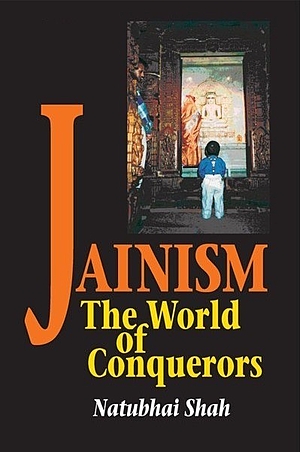India is a land of religious people. In the West people see religion as a mental and spiritual activity but in the East people think of it as activity concerned with all aspects of mind, body and speech, so that every person, irrespective of his or her outlook, is a religious person. In India, the word usually translated by the English word 'religion' is dharma, but dharma has a wider connotation, it involves the individual's duties and functions, physical and spiritual, throughout life. It is a way of life, thought and action, unlimited in scope. However, traditionally, the dharma is defined as those activities, which lead one to total happiness and self-realization. It is this meaning of dharma that we shall use throughout this dissertation.
In the Jain view, the ideal religion would be capable of being a universal religion having the widest possible appeal. However, we know from history and our own experience that the world's major religions such as Hinduism, Buddhism, Sikhism, Jainism, Christianity, Islam and Judaism have so far been of limited or qualified appeal. Some of these religions are named after a historical figure, Christ or Buddha, some after a nation or its lands, Hind or Judah, and others after particular qualities, Islam (submission to God). Jainism falls into the latter category, taking its name from Jina (self-conqueror). Jainism sees self-conquest as a goal to which all human beings should aspire. It is in this that modern Jains see its potential for universality.
The Indian sub-continent has long been a land of many religions: today Hinduism, Islam, Christianity, Sikhism, Buddhism and Jainism are all - important living religions. Though the 1981 census shows a fairly small number of Jains, around three millions, the number of people who follow the Jain way of life, whether consciously or not, is many times more, not only in India but also throughout the world. Jain organizations in India estimate that the number of de facto Jains may be as high as twelve million. The discrepancy in the figures of Jain organizations and official figures may be due to the fact that in the19th century British rule gave the name Hinduism to the coalition of religions that existed in India (Bowker 1997: p.18).
There has long been confusion, among scholars as well as ordinary people, regarding the history, origin and status of Jainism. It is only in the last hundred years that Eastern and Western scholars have studied this religion and the results of their researches have done something to clear the clouds of confusion which long veiled Jainism. Dr. S. Radhakrishnan, the great philosopher, scholar, who was the President of India (1962- 1967), wrote 'Jainism is a Pre-Aryan religion, which prevailed in India long before Mahavira and Parsva, the last two tirthankaras' (Radhakrishnan 1929-31: vol. 1, pp.287). In 1947 Pandey has stated that the anti-ritualistic tendency, within the Vedic fold is the impact of an asceticism (predominant in Jainism) which antedates the Vedas. (Pandey, quoted in Roy 1984: p.12). The scholars such as Hiralal Jain, Zimmer, Jacobi, Vincent Smith, and Furlong have studied Jainism and the results of their researches have cleared the clouds of confusion surrounding Jainism.
These scholars have confirmed that it is without doubt one of the oldest religions of India, distinct in its own right from Buddhism (with which it was long confused in Western eyes) as well as from other Indian faiths. In the Majjhima Nikaya (Mahasimhanada Sutta: 1,1,2), it has been noted that the Buddha was from the sramana tradition and undertook rigorous ascetic practices such as pulling one's hair and fasting; these practices are similar to those of the disciples of Parsvanatha, the twenty-third tirthankara of the Jains. Both Dhamananda Kosambi and Pandit Sukhlal claim that the Buddha did adopt the practices of Parsva tradition, the fourfold practices of conduct, before he developed his system. According to the historian Radhakumuda Mukharjee, the Buddha developed his way of life after attempting the Jain and Vedic practices; this has been confirmed by Mrs. Rhys Davids in her book 'Gautam, the Man' (1928: pp. 22-25).
Much scholarly work has been devoted to tracing the early history of Jainism, though the origins of the religion lie far back in prehistory and the beyond scholarly reconstruction. Jain writings have preserved an extensive and consistent legendary history. In contrast to this traditional account, modern scholarship has reached widely varying conclusions, though confirming in some parts the traditional view.
The study of history never had the importance in India, which it has had in the West or in China and much of the early history of India, and not only of Jainism, is still obscure. Research in the last century or so has increased our knowledge of India before the time of Alexander the Great.
It is possible to look at the early history of Jainism through sources of four kinds:
- Literary,
- Archaeological,
- Scientific-Geological and
- Philosophical.
These have been studied by, among others, J.P. Jain in Jainism, the Oldest Living Religion (1988). The main characteristics of Jainism do exhibit a primitive and prehistoric substrata, though dynamic in its development.
(i) Literary Sources: It must be emphasised that many of the conclusions regarding early Jainism drawn from early literary sources are highly speculative, depending often on the individual interpretations of particular scholars regarding chance references in the sources studied, the Vedas, Puraanas, and other historical records. Thus it is said that Jainism was in existence in the period of the Mahabharata, the great Indian epic.
A copper plate inscription discovered in Kathiawar (Gujarat) in 1935 recording a grant to a king of the Sumera tribe who built a temple to Neminatha, the twenty-second Jain tirthankara, at Rasvataka (Girnar), is adduced as confirmation. The Rigveda, said to be the earliest book still extant and reputed to date in part from as early as 4,500 BCE, though reaching its final form around 1,500 BCE, includes hymns referring to the first tirthankara Risabhdeva. It describes him as a great man from the sramana (that is, Jain) tradition and refers also to the twenty-second tirthankara Neminatha (Jain J.P.1951 pp.20-24). The ancient writings known as Puranas follow the Rigveda and even gave Risabhdeva the status of one of the incarnations (avataaras) of the god Vishnu (Chatterjee A.1978: p.7). Later Indian literature contains references to the same effect. It is said that the traditional name for India, Bharat, has been derived from that of Risabhdeva's son, Bharat (Kalghatgi 1988: p.28). The historicity of the twenty-fourth tirthankara, Mahavira, and his predecessor Parsvanatha, some 250 years earlier, has been proved beyond doubt.
(ii) Archaeological: The epoch making discovery of the prehistoric Indus Valley Civilization (c.4,500 to 1,500 BCE) at Mohenjodaro and Harappa (now in Pakistan) has provided material on the basis of which some have concluded that Jainism existed already during this ancient civilization (Moh. Ind, plate xii, Fig. 13, 14, 15, 19, 22). The evidence is capable of many interpretations: here, for what they are worth, are the main pointers. Nude figures in standing posture have been interpreted as Jain yogis in the relaxed standing meditational (kaayotsarga) position widely found in Jain iconography. Similar figures appear on some of the seals excavated at these sites. Seals have been found bearing the image of a bull, the emblem of Risabhdeva. Hooded figures may represent the seventh tirthankara Suparsvanatha, whose main iconographic characteristic is a hood formed by seven snakes. Attempts to interpret the Indus Valley script have been largely unsuccessful, though the historian Pran Nath Vidyalankar has read the inscription of seal No. 449 as jineshvar or jinesha, possibly representing the Jina or self-conqueror, a term used for the tirthankara. He also seems to have deciphered the incantation srim hrim klimek, used (but not exclusively) by the Jains (Shah D.T.1965: pp.559-560). If one accepts the interpretation of this, admittedly problematic, evidence, the existence of Jainism can be traced back to pre-Aryan, pre-Vedic times, and to the original Dravidian inhabitants of northern India, perhaps as far back as the seventh millennium BCE.
(iii) ScientificGeological: It appears that the last ice age ended about 8,000 to 10,000 years BCE. In the succeeding post glacial age it is thought that Aryan peoples began moving south towards India. They found a good level of civilization at the borderline between the Neolithic, or new stone age, and the chalcolithic age when copper and stone implements were in use side by side (Jain K.C. 1991: p.4). This is the period when the civilizing work of the first tirthankara, reputed in Jain tradition to have introduced humanity to the new useful arts, could have taken place.
(iv) Philosophical Evidence: Certain Jain philosophical or cosmological principles suggest great antiquity. Three examples may make this clear:
- The concept that life exists in all things, except limited range of pure matter, is characteristic of Jain thought and seems to be of ancient origin;
- The concept of cyclical time is found in Buddhism and in other ancient religions;
- Buhler has referred to the third concept supporting the antiquity of Jain thought (Buhler 1908, Tr. By Burgess 1963: p.7). It is the identity or non-difference between a substance and its attributes. This has been modified by the later concept of 'relative pluralism' (anekaantavaada), a characteristic of Jainism seeing all facts from multiple viewpoints.
Undoubtedly, the Jain religion is of great antiquity. The simple fact is, however, that given the present state of our knowledge, any attempts to trace or date its early history are speculative.
 Dr. Natubhai Shah
Dr. Natubhai Shah
